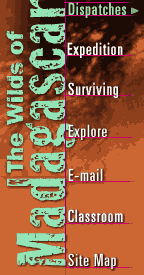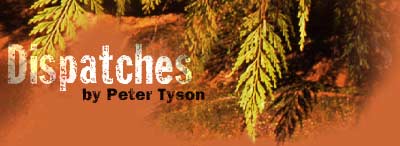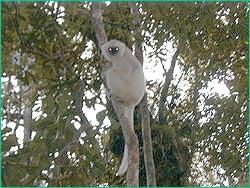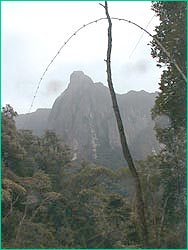 |
 
56k | ISDN Get RealPlayer software |
 May 31, 2000 Angels of Marojejy
When Pat Wright first saw the silkies, Jacinth O'Donnell told me later, she had a tear in her eye. Wright was elated, of course, to finally spot the subject of a research trip she had planned for years. But there was more behind that emotional response. We've been here in the Marojejy Reserve for less than two days, and already we've had a serious crisis. During the long hike up here on Monday, a blister on my foot became infected. In the tropics, infections can escalate quickly, and mine did. By yesterday evening, despite starting antibiotics the night before, the infection had caused my foot to balloon out to half again as fleshy as my other foot. My bones normally poke through the skin of my feet, but yesterday one couldn't see the place where my foot ended and my toes began. My foot turned red, became warm to the touch, and could not be stood upon even lightly. I began to run a fever, and I lost my appetite. Around six o'clock last night we had a pow-wow outside my tent. Malagasy and Westerners alike pressed close around my foot, which I rested on a bucket, examining it and offering suggestions. It was decided that if my foot had not improved by early morning, I would hike out, drive back to Sambava, and, if necessary, fly to Antananarivo. It was not a pleasant prospect. For one thing, it had been a strenuous five-hour hike up here, and that was with two good feet. How would I fare on a homemade crutch? And there was the online expedition to think of.
At 4:30 a.m., a time we'd set to make a decision, my alarm went off. Even before I could grab my headlamp, I realized I felt better, and one look at my foot showed I wouldn't need to hike out after all. The swelling had gone down, the pain and redness had subsided, and my fever was gone. I ate an entire bowl of rice porridge. Mireya Mayor, who has very kindly been treating my foot over the past two days, soon arrived at my tent, followed by Wright and others. They all concurred that the crisis had passed, and I should stay put, continuing the antibiotics and keeping my foot clean and raised. After an early breakfast, a relieved team headed across the creek to try their luck again with the silkies. Yesterday they'd done several exhausting hikes up the steeply inclined ridges around camp, with no luck. But just after crossing the stream, there they were, the "most beautiful lemur in the world," according to my guide Desiré Rabary, bouncing effortlessly through the trees. Using a walking stick hacked from a stout branch, I hobbled down to the streamside in hopes of catching a glimpse of these ethereal-looking lemurs. I even wrapped a white sheet around my shoulders, as Rabary had told me the silkies are attracted to anything bearing their own color. But I arrived at the end of their brief sojourn here, and all I saw through my binoculars was the flick of a branch as they moved off.
"They're the most beautiful sifaka I've ever seen," said Mayor, her face flushed with excitement. She has seen quite a few species, including the silky's all-black cousin, Perrier's sifaka. "I consider them the angels of Marojejy." After recent improvements here at Camp Two, she'll have no argument from me. Peter Tyson is Online Producer for NOVA. We'll keep you up-to-date on other developments as they occur here at Marojejy. Stay with us. Dispatches Forest of Hope (June 7, 2000) A Great Day for Silkies (June 4, 2000) Camp Life Unveiled (June 3, 2000) Three Hours with the Silkies (June 1, 2000) Angels of Marojejy (May 31, 2000) Wildlife (May 30, 2000) Into the Marojejy Massif (May 28, 2000) Croc Cave (May 26, 2000) Fossa! (May 25, 2000) Bat Cave (May 24, 2000) Update: English Camp (May 23, 2000) Update: Sunken Forest (May 21, 2000) Update: Night Walk (May 20, 2000) Update: 70 Feet Up (May 19, 2000) Update: Tropical Downpour (May 18, 2000) Photos: (1) Mireya Mayor; (2,3) Peter Tyson. The Expedition | Surviving The Wilds | Explore Madagascar Dispatches | Classroom Resources | E-Mail | Resources Site Map | The Wilds of Madagascar Home Editor's Picks | Previous Sites | Join Us/E-mail | TV/Web Schedule About NOVA | Teachers | Site Map | Shop | Jobs | Search | To print PBS Online | NOVA Online | WGBH © | Updated November 2000 |
 The Marojejy team caught its first fleeting glimpse of the silky sifaka this
morning, just after breakfast. It was the second auspicious sign of the day.
The Marojejy team caught its first fleeting glimpse of the silky sifaka this
morning, just after breakfast. It was the second auspicious sign of the day.
 Despite the seriousness of the situation, after hours of treating and worrying about the infection, we all got a bit giddy at the thought of all these primate researchers studying my foot. From left to right, Pat Wright,
Mireya Mayor, Mike Kraus (who has come on his own to study the silky
sifaka), and producer Jacinth O'Donnell continue the vigil at about eight o'clock last night.
Despite the seriousness of the situation, after hours of treating and worrying about the infection, we all got a bit giddy at the thought of all these primate researchers studying my foot. From left to right, Pat Wright,
Mireya Mayor, Mike Kraus (who has come on his own to study the silky
sifaka), and producer Jacinth O'Donnell continue the vigil at about eight o'clock last night.
 The bald-faced mountain that stands sentinel over our camp, as it appeared
early this morning from Camp Two.
The bald-faced mountain that stands sentinel over our camp, as it appeared
early this morning from Camp Two.